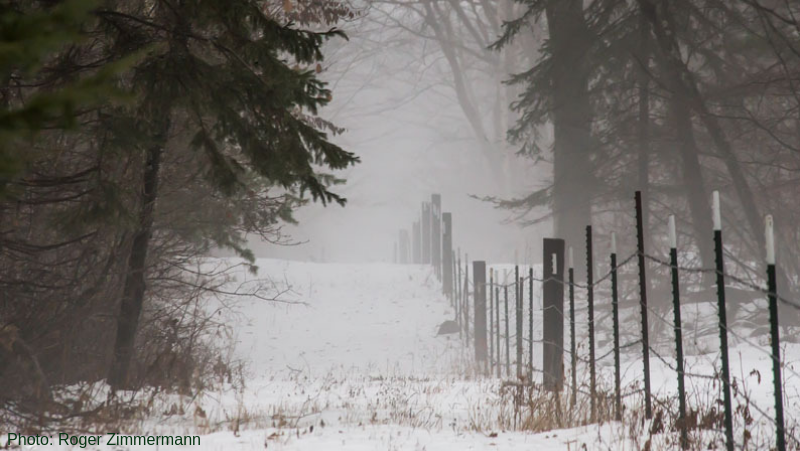On November 23rd, the White House released the Fourth National Climate Assessment, a multi-agency review of the changes to our climate that have already occurred in the United States. The report includes key messages for the Midwest related to agriculture, forests, biodiversity and ecosystems, human health, and transportation.
Land trusts and the communities they serve can take steps to learn more, communicate the urgency of the issues, and take action. Notably, Wisconsin gets a mention in the report with the example of Ozaukee Washington Land Trust’s open space preservation efforts (see Key Message 5: Transportation and Infrastructure).
Below, we share information and talking points from Openlands, a land trust in the greater Chicago region. These points help prepare conservation organizations and concerned citizens to advocate for climate action.
1. It’s not too late to do something.
One of the most important things to always keep in mind is that it is not too late to act. The 2015 Paris Agreement created a global framework wherein signatory countries would work to reduce their greenhouse gas emissions. The goal is to keep global warming to no more than 2 degrees Celsius (3.6 F). At that point, we must still expect significant changes in our climate, but we will avert catastrophe. Additionally, the Paris Agreement set the aspirational goal of limiting warming to 1.5 degrees (2.7 F) to create a type of safety net. There is still a chance that we can reach that goal.
2. Climate projections are viewed on a scale, and we can act to reduce and prevent some impacts.
Climate change reports often present their findings with both a best case scenario and a worst case scenario. Both the Fourth National Climate Assessment and the landmark report from the UN’s Intergovernmental Panel on Climate Change (IPCC) issued in October 2018 emphasize the importance of what are known as mitigation and adaptation tactics to address this crisis.
Mitigation is the process of reducing greenhouse gas emissions and increasing efforts to pull greenhouse gases from the atmosphere. Adaptation refers to the actions we can take to prepare for the impacts and reduce the risks of climate change. Land trusts can embrace both of these strategies, and use solutions based in nature to put carbon back in the ground.
3. Forests and land conservation are more important than ever.
Both the reports from the federal government and the IPCC stress the importance of forests and land conservation as central elements in preventing climate change from wreaking ecological devastation. Large, healthy woodlands with hardy native species and vast sweeping prairies filled with grasses and deep-rooted plants suck in and absorb massive amounts of carbon from the atmosphere while providing havens for wildlife.
The National Climate Assessment states that, “species and ecosystems, including the important freshwater resources of the Great Lakes, are typically most at risk when climate stressors, like temperature increases, interact with land-use change, habitat loss, pollution, nutrient inputs, and nonnative invasive species.”
The good news is that so many of these risks can be avoided today. For one, we know how to protect clean water resources: we know that plants and open space can manage stormwater, removing harmful pollution and keeping adjacent waterways healthy. Trees in urban areas not only pull pollution and carbon from the air, but also lower temperatures on the ground. And we know that restoring natural areas leads to healthier landscapes that mitigate greenhouse gases more efficiently.
Ecological restoration has additional benefits beyond absorbing carbon, which include flood relief, pollution reduction, controlling invasive species, improved water quality, and better habitat for wildlife.
4. Heat and humidity are expected to impact human health.
Unfortunately, we have to expect that increased temperatures will unleash new complications to human health in our region. Higher temperatures and higher humidity increase the risk for heat stress, the ferocity of storms, mold and fungal disease such as oak wilt, and the potential for poor air quality resulting from smog. We can expect to see these hazards affecting those with asthma and chronic health conditions.
5. Agriculture in the Midwest is at risk.
The United States produces nearly $330 billion in agricultural commodities annually. Agriculture is vulnerable to direct impacts on crops and livestock from changing climate conditions and extreme weather events, as well as indirect impacts like new insects and diseases. While heat stress on crops in the Midwest has been minimal, increased spring rainfall has made planting more challenging, and wet conditions in the fall can impact the timing and quality of a harvest.
Working with farmers to implement adaptive practices on their land is critical. Integrating native prairie plants into row crops, for example, has been shown to reduce sediment and nutrient loss from fields, as well as improve biodiversity and ecosystem services, such as flood control and carbon sequestration.
6. Water levels in the Great Lakes may be impacted.
There have been lots of news stories this year showing how water levels in Lake Michigan are at near-historic highs and there’s a temptation to claim prematurely a link to climate change. The reality is that we are not sure what is going to happen with water levels in the future. We can expect the Great Lakes region will get warmer and to experience warmer winters, meaning there will be greater evaporation from the lakes year-round.
7. Climate change is felt most by the most vulnerable.
Much like poverty, disease, crime, or debt, climate change can affect anyone, but the effects are concentrated among those who are most vulnerable. Children, elderly adults, and frontline communities will feel the health impacts of a changing climate the most. Frontline communities are often low-income and communities of color and tend to face disproportionate exposure to environmental hazards, pollution (such as congested highways or power plants), inequitable access to green space, and poor air quality leading to higher rates of asthma.
Many thanks to Openlands for permitting us to share their talking points here. See “Unpacking the National Climate Assessment and What We Can Do” for the full discussion.
We are further exploring the report and encourage you to explore it too, and share key ideas for action in your community. The National Climate Assessment is presented online in a user-friendly manner, or can be downloaded in full or in sections.



